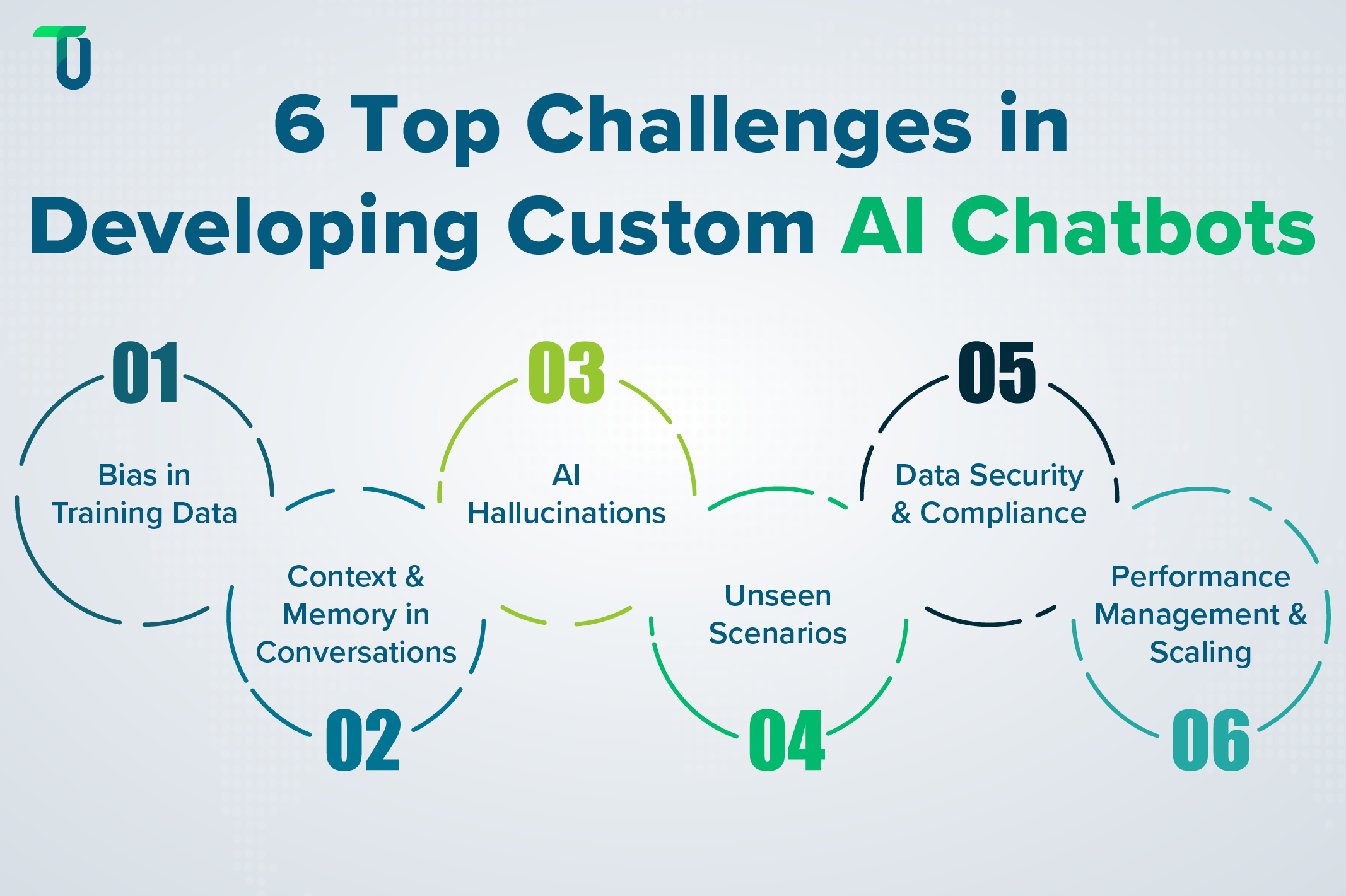Key Challenges in AI Chatbot Development with Solutions to Navigate Them
With the immense benefits that AI chatbots provide businesses, it’s no wonder that the global chatbot market size is projected to grow at a notable 23.3% CAGR between 2025 and 2030, according to Grand View Research. This statistic really just confirms the latest trend of rapid AI adoption in businesses.
But businesses will get true value only when they navigate the challenges of building reliable AI solutions, including chatbots. We’ve compiled the information below on the real challenges in building AI chatbots and solutions to navigate them based on our experience building chatbots for many clients. We sincerely hope you will find this information of value.

Challenge 1: Eliminating Bias from AI Training Data
AI learns from data, and if your training data sets have inherent biases, they will reflect in the responses of your AI chatbot. A study by MIT and Stanford researchers revealed how a lack of diverse data in training an AI-based facial recognition system led to a gender and skin-type bias in its responses.
This issue is big because an AI system trained on biased data can not only give false results but can also risk your company’s reputation. So, removing bias from training data should be a key part of your AI development strategy and not an afterthought.
Another form of bias that may take a backdoor entry into your training datasets is historical bias. Did you know that Amazon once scrapped its AI recruitment tool because it favored male candidates and gave lower scores to keywords related to women? The reason was that the AI algorithm was trained on resumes of past hires that were predominantly male, also called algorithmic bias. This means, if bias already exists in your historical data, probably due to earlier practices involving prejudices, you need to remove it.
There are many other forms of biases that can enter your data even during the AI chatbot development process, like:
- Labeling bias due to poor data labeling practices.
- Evaluation bias resulting from overconfidence in your AI model’s capabilities.
- Aggregation bias occurs because you combine data from different sources without highlighting core differences.
So, what’s the solution?
Start by collecting diverse data sets. For instance, if you’re building an AI chatbot to cater to customers from different regions or segments, collect data in different languages and dialects, as well as domain-specific nuances for AI training.
Also, if you really want to remove gender and social biases from your AI system, consider getting your training data reviewed by external authorities or experts
We highly recommend auditing your training data periodically, preferably using relevant tools, to ensure it is bias-free before it moves to the production environment.
Techniques like MLOps, LLMOps, data governance, and AI governance can help.
Use the right data labeling practices to remove labeling bias and establish the correct model evaluation processes using the right metrics to do away with evaluation bias.
Take care of aggregation bias at the data preparation stage, which involves collecting, cleaning, and structuring data for AI training purposes.
These solutions should take care of your data bias challenge. So, after you have removed bias and trained your AI chatbot thoroughly, next comes the challenge of making it deliver human-like conversations.
Poor AI chatbot performance troubling you?
Getting accurate results from AI integration can be difficult, but not impossible. All you need is the right guidance. Our AI experts can help.
Challenge 2: Maintaining Context and Memory in Conversations
The key difference between traditional rule-based chatbots and the latest AI-powered chatbots is that the latter can have meaningful conversations and provide personalized responses. But building this capability is not easy. Even after you’ve developed a custom AI chatbot using appropriate architecture and trained it on language nuances, the complexity of dialogue management still prevails.
AI chatbots must remember the previous conversations and respond accordingly, just as humans do. If not, they will ask users to repeat information and frustrate them. Also, in real-world scenarios, users may not always conduct the conversation in a straight flow. They may ask about something new in the middle of a topic or shift topics continuously.
So, your AI chatbot needs effective dialogue management to remember past interactions, seamlessly transition between topics, and track user preferences to deliver context-aware conversations. You can:
Manage State: Implement a system to track the conversation and monitor the current state, including active topics, user goals and unresolved queries, so your chatbot can maintain context. Store user-specific relevant information in appropriate memory buffers to help the chatbot deliver personalized responses.
Design Conversation Flows: Use visual tools to map out different paths the users could take within a conversation, and carefully design multiple conversation flows. Consider the potential issues or dead ends your chatbot could face during the conversation and design accordingly.
Track Context: Employ techniques like intent classification, entity recognition, and sentiment analysis to track the context of conversations. Use algorithms to enable the chatbot to recognize when the user has shifted intent.
Handle Errors: Build error-handling mechanisms for when users give erroneous or unexpected information. Create informative messages for the chatbot to guide the users back on track in their conversations.
Sync Conversations Across Devices: Your users could start the conversation on the mobile app and move on to a web app on their mobile or tablet to finish it, adding another complexity of data persistence. Have backend systems to sync conversation states across platforms and devices.
After building the capability of delivering meaningful conversations in your AI chatbot, it’s time to encounter another challenge: your chatbot must not give misleading or incorrect information to users.
Challenge 3: Mitigating AI Hallucinations
Have you come across a conversational AI-based system giving factually incorrect information but sounding extremely confident? That’s AI hallucination. It’s a phenomenon when AI generates responses based on unsubstantial or misunderstood patterns in data. It could also be a result of limitations in how large language models (LLMs) understand context or handle ambiguous queries. So, when unsure, AI guesses to respond, which could be misleading.
It negatively impacts the outcomes of AI-based systems, especially in sectors like healthcare, finance, and legal services. For example, an AI-based system giving incorrect medical diagnostics or a false legal citation in a court case could lead to serious consequences.
This emphasizes the need for careful AI development and continuous oversight. Think of your AI chatbot as a junior employee who is highly capable but is still learning. Similarly, AI learns from data initially, and then continuously learns from its experiences and environment. But before bringing it to production, it's essential to check why and when it hallucinates and take remedial action.
Here’s what you can do to mitigate AI hallucinations:
Identify Causes: Check when and why your AI chatbot hallucinates. Analyze model architecture, check for gaps in training data, and understand patterns that trigger hallucinations.
Take Remedial Action: Based on your analysis, fix the problem, be it improving data quality by bringing in diverse, underrepresented data or enhancing model architecture by applying regularization to reduce overfitting.
Monitor Continuously: Set up continuous monitoring mechanisms for high observability and evaluation of AI models. Implement feedback loops and allow users to flag inaccuracies.
Set Confidence Thresholds: Score AI outputs on their confidence levels and implement thresholds, so a low-confidence output (potential hallucination) gets flagged for human review.
Follow Ethical Practices: Provide disclosures to users on the limitations of your AI system so they consider AI outputs critically and report errors.
After working on mitigating AI hallucinations, the next challenge is to enable your chatbot to tackle unforeseen situations independently.
Challenge 4: Handling Unseen Scenarios
Even the most well-trained AI chatbot will someday encounter a scenario or question it has not addressed before. Your chatbot’s most natural response, as per its training, will be to understand the user's intent, leverage the knowledge base, and try to come up with a response. Again, there's a risk that it will hallucinate because it has no knowledge or experience of answering such a question. So, you must make provisions for what the chatbot must do when it encounters unseen scenarios.
Consider these solutions:
Implement Fallback Protocols: Create a flow for your chatbot so it first activates the error handling mechanism and asks for additional information from the user. It must then escalate the issue to the human agent.
Gather Data to Improve AI Performance: Train the chatbot to store these new types of user queries and intent. Additionally, activate feedback loops by allowing users to rate answers or flag issues. Use this collected intent, query, and feedback data for fine-tuning the LLM on new, unseen scenarios.
After tackling all the above challenges, your chatbot should now be ready for production, right? No. Not before you look into the following challenge and ensure your business data is safe at all times.
Challenge 5: Ensuring Data Security, Privacy, and Compliance
As AI chatbots cater to customers across industries in finance, healthcare, etc., they handle sensitive personal data of customers from their finances to health-related records. So, ensuring robust data security and privacy is non-negotiable. With data regulations like GDPR, HIPAA, and CCPA getting stricter by the day, you cannot risk ignoring compliance as well.
Here are some solutions that can help you:
End-to-End Encryption: Prevent interception of data both in transit as well as in rest by encrypting it.
Authentication and Access Control: Have secure authentication processes and protocols in place, along with limited access using role-based permissions.
Built-in Compliance: Don’t keep compliance with regulations like GDPR, HIPAA, etc., for later. In fact, make it the foundation of your data security and privacy efforts.
Regular Security Audits: Set up testing best practices using relevant tools to detect and fix vulnerabilities early. Check if all third-party integrations, like APIs or external services, are secure. Back up configurations and data regularly, and keep security documentation in order.
Expert Tip: For the purpose of AI chatbot development, provide access only to the data that the chatbot absolutely requires for smooth functioning. Minimal data sharing means you have fewer data pieces to worry about.
With this, your AI chatbot is ready for the production environment and capable of facing your customers or the real intended users. But it’s not yet the end of your challenges. Read further about what you can expect post-deployment.
Challenge 6: Performance Management and Scaling
Once you’ve built your custom AI chatbot and it's doing its job well, it's not the end of the journey- just a phase that is complete. The next phase starts now because your customers’ expectations are evolving, and so is your business. And hence, your chatbot too must adapt, learn, and grow.
If not, the chatbot will keep responding using outdated knowledge, error rates will increase, and customer satisfaction rates will drop notably. Also, your chatbot must remain responsive without compromising performance during high traffic times and scale to handle higher volumes due to business growth.
Here’s how you can manage and improve the performance of your AI chatbot:
Track Essential Performance Metrics: Define clear performance benchmarks for your chatbot by setting up metrics like resolution rate, escalation frequency, average response time, user satisfaction, fallback percentage, etc., and monitor them regularly. Any deviation is your hint to intervene. Identify causes and take remedial action to manage chatbot performance at all times.
Gather & Use Fresh AI Training Data: Analyze your chatbot’s conversations using logs and dashboards to spot trends in questions, problem areas, and missed intents. Use this data to feed new intents and retrain your AI model. Based on your observations and evolving business needs, refine your chatbot’s workflows so it stays relevant.
Consider the following solutions for scalability:
Scalability by Design: High AI chatbot traffic can overload existing systems. Go for scalability by design with cloud solutions. Platforms like AWS, Azure, and Google Cloud offer resources that adjust to traffic fluctuations. So, your chatbot can handle varying loads and remain responsive during peak usage times.
Load Balancing and Asynchronous Processing: Distribute chatbot traffic evenly across multiple servers to prevent system overload. Adopt asynchronous processing so your chatbot can handle multiple requests concurrently.
Caching and Resource Management: Caching frequently used data, like common queries or session information, can help reduce latency and server load. By minimizing redundant processing, your chatbot can deliver quick responses.
Regular Load Monitoring: Use the right monitoring tools to track your chatbot’s performance on key metrics like response time, error rates, system load, etc., in real time. Set automated alerts to flag anomalies so you can address and resolve them early. Also, establish processes to load test the system regularly to ensure it is resilient during high traffic times.
Capacity Planning: Plan ahead to estimate future resource requirements based on expected business growth. Create a clear scaling plan for your infrastructure (On-premise or Cloud) to support the increase in chatbot usage.
We’ve tried to cover the most pressing issues or roadblocks that most AI chatbot development projects usually face. However, this compilation is not comprehensive. If you wish to get more guidance, our experts are ready to help.
Turn AI Chatbot Development Challenges into a Lasting Success
It’s one thing to build AI chatbot solutions, and another to develop the ones that truly deliver on your business goals, not just now but even when your needs evolve. That’s the difference between deploying a tool and creating a long-term, strategic asset.
We’ve discussed the critical challenges in AI chatbot development, from bias in training data, contextual memory, hallucinations, and security concerns during production to performance issues post-production. And we’ve also offered practical ways to navigate each of these challenges. These are ongoing focus areas that determine whether your chatbot creates friction or drives real value.
At TenUp, we provide businesses with more than just chatbot development services. We help them develop intelligent, secure, and scalable AI solutions that evolve alongside their goals. Whether it’s streamlining recruitment, boosting operational efficiency, or enhancing customer experience, we build AI solutions to deliver lasting success.
See this in action. Check out how our custom AI chatbot automated the time-consuming candidate search process essential in the recruitment industry. Also, explore our case studies across industries like manufacturing, logistics, and more here.
Looking to leverage AI to build or scale a chatbot?
Our AI experts can help! Just let us know what you need, and we’ll tailor an AI solution for your business.
Frequently asked questions
What are the best platforms or frameworks for building AI chatbots?
Top platforms like Botpress, Rasa, and Dialogflow offer powerful tools for building AI chatbots. Botpress stands out for its modular architecture and LLM support, while Rasa provides open-source flexibility, and Dialogflow excels in Google Cloud integration, making them ideal for custom, scalable solutions.
How can I integrate an AI chatbot with my existing CRM or ERP systems?
At TenUp, we integrate AI chatbots with CRMs like Salesforce and ERPs like SAP using secure APIs or custom middleware—enabling real-time automation, personalized interactions, and streamlined data workflows tailored to your business systems.
What are the cost considerations for developing and maintaining an AI chatbot?
Costs depend on the chatbot’s complexity, required integrations, and long-term support needs. Key factors include development scope, training data quality, UI/UX design, maintenance frequency, and integration with platforms like CRMs or ERPs.
How do I ensure my AI chatbot complies with data protection regulations like GDPR and HIPAA?
Design your chatbot with privacy by default—limit data collection, get explicit user consent, ensure secure data handling, and allow users control over their data. Regular audits and clear policies are essential for ongoing compliance.
Can AI chatbots handle multiple languages, and how is multilingual support implemented?
Yes. AI chatbots use NLP and machine learning to detect, understand, and respond in multiple languages. They’re trained on multilingual datasets, ensuring accurate translation and contextual replies for a seamless global user experience.
What metrics should I track to evaluate my chatbot's performance effectively?
Focus on KPIs like goal completion rate, user engagement, resolution time, fallback frequency, and customer satisfaction. These help assess how well your chatbot meets user needs and drives business outcomes.

